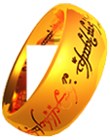Things of Middle-earth
Eagles
Type: Animals
Other Names: Eagles of Manwë
Description:Eagles are often referred to 'Eagles of Manwë' or 'Eagles of the Lords of the West'. Aside from comments in 'The Hobbit' which will be dicussed below, all mention of eagles indicates their sacred origin and nature as Maiar who serve Manwë.
"Manwë however sent Maia spirits in Eagle form to dwell near Thangorodrim and keep watch on all that Melkor did and assist the Noldor in extreme cases."
Morgoth's Ring, Part Two, The Annals of Aman, Commentary - 169
"For Manwë to whom all birds are dear, and to whom they bring news upon Taniquetil from Middle-earth, had sent forth the race of Eagles, commanding them to dwell in the crags of the North, and to keep watch upon Morgoth; for Manwë still had pity for the exiled Elves. And the Eagles brought news of much that passed in those days to the sad ears of Manwë."
Silmarillion, Chapter 13, Of the Return of the Noldor
The eagles are mentioned in the history of Numenor, their role changing from symbolic in the times before the shadow:
"… the great eagles that were held sacred to Manwë, and never afflicted, until the days of evil and the hatred of the Valar began. For two thousand years, from the days of Elros Tar-Minyatur until the time of Tar-Ancalimon son of Tar-Atanamir, there was an eyrie in the summit of the tower of the King's palace in Armenelos; and there one pair ever dwelt and lived on the bounty of the King."
Unfinished Tales, Part Two: The Second Age, Description Of The Island Of Númenor
To warning or avenging spirits when Numenor was slipping into shadow:
"And some of the eagles bore lightning beneath their wings, and thunder echoed between sea and cloud."
" 'Behold the Eagles of the Lords of the West!' they cried. 'The Eagles of Manwë are come upon Númenor!' And they fell upon their faces."
"Then the Eagles of the Lords of the West came up out of the dayfall, and they were arrayed as for battle, advancing in a line the end of which diminished beyond sight; and as they came their wings spread ever wider, grasping the sky. But the West burned red behind them, and they glowed beneath, as though they were lit with a flame of great anger, so that all Númenor was illumined as with a smouldering fire; and men looked upon the faces of their fellows, and it seemed to them that they were red with wrath."
The Silmarillion, Akallabeth
'The Hobbit' mentions eagles in general less reverently:
"Eagles are not kindly birds. Some are cowardly and cruel. But the ancient race of the northern mountains were the greatest of all birds; they were proud and strong and noble-hearted. They did not love goblins, or fear them."
The Hobbit, Ch 6, Out of the Frying-Pan into the Fire
One can extrapolate that there is a distinction between mundane eagles and the "ancient race" mentioned above which were descended from Manwë's eagles. This would give a division similar to that for spiders: everyday ordinary spiders, and the spawn of Ungoliante such as Shelob.
'The Hobbit' goes on to say:
"And so they parted. And though the lord of the eagles became in after days the King of All Birds and wore a golden crown, and his fifteen chieftains golden collars (made of the gold that the dwarves gave them), Bilbo never saw them again-except high and far off in the battle of Five Armies. But as that comes in at the end of this tale we will say no more about it just now."
The Hobbit, Chapter 7, Queer Lodgings
There are four named eagles in Tolkien's writings: Gwaihir, Landroval, and Meneldor mentioned in LotR, and Thorondor who is mentioned in tales of the First Age. These are the final names used, but several versions of these names exist in The History of Middle-earth. 'The Hobbit' mentions only 'The Lord of the Eagles', possibly Gwaihir.
Contributors: Lyllyn 1.17.03
